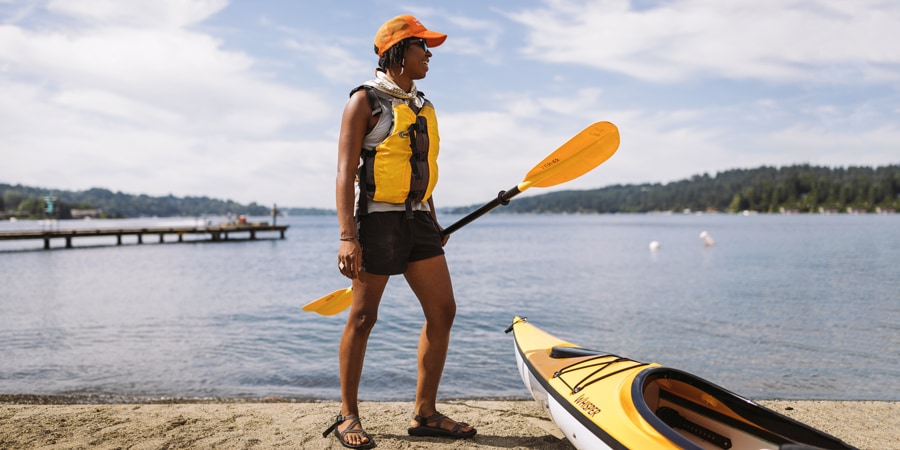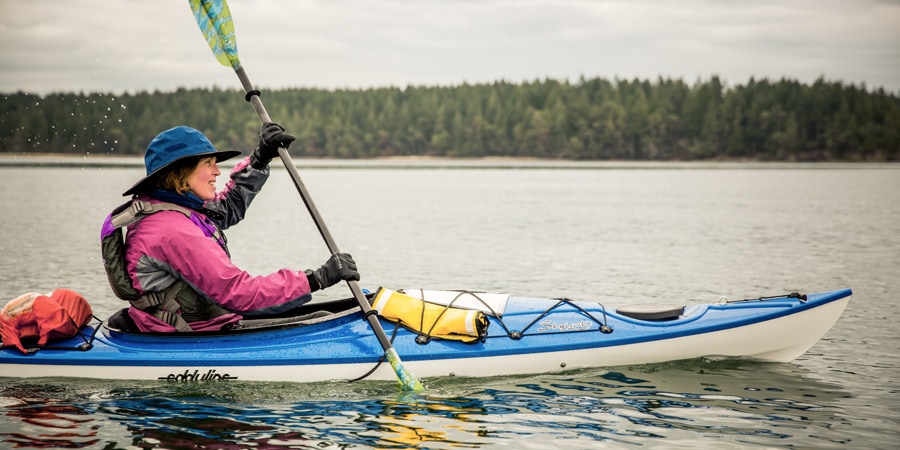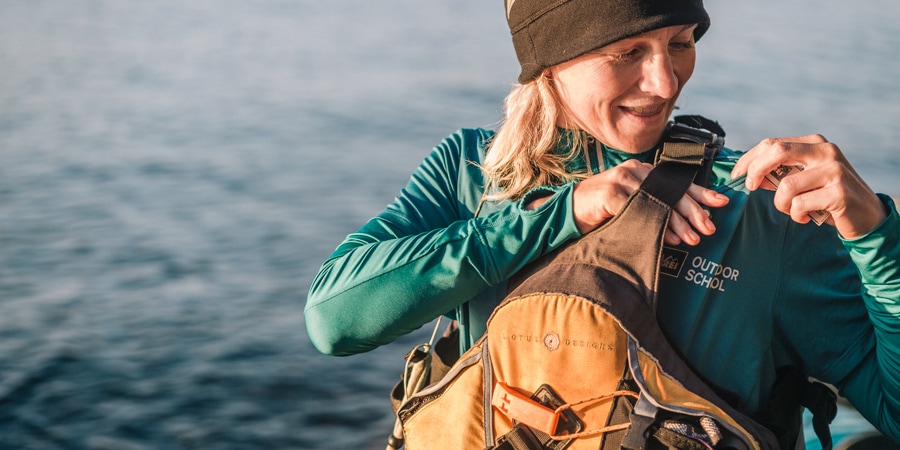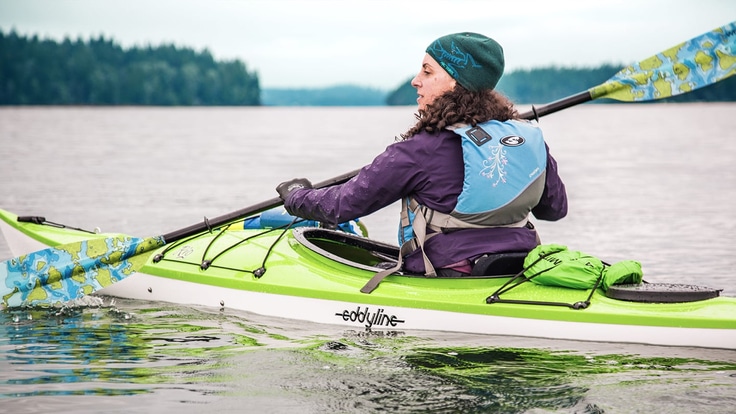Clothing for kayaking has similar requirements to other outdoor activities like hiking: You're looking for versatility, durability and comfort while you're on the move. You're also looking for protection for cold and wet conditions (really wet conditions).
When deciding what to wear kayaking, follow these general guidelines:
- Always wear a personal flotation device (PFD) and never take it off while on the water. If you need to adjust your top layers, find a place to take out instead. You can also "raft up" with a kayak buddy holding your boat firmly while you change, though changing on shore is the better option.
- Dress for the water temperature, not the air temperature; this may mean wearing a wetsuit or dry suit.
- Dress in layers, especially on top.
- Dress for sun protection. Regardless of cloud cover, a day on the water is a day of sun exposure. So wearing clothing with UPF-rated fabrics is a wise choice (plus sunscreen for reflected UV radiation).
- Avoid cotton in all layers, because it absorbs water and stays wet; seek quick-drying fabrics instead. For any clothing layer that touches your skin, go with wicking, quick-drying nylon or polyester (or another synthetic fabric). Wool dries less quickly, but insulates when wet, so is also a fine choice.
- Wear clothes that let you move comfortably and will be comfortable for long periods of sitting.
- Look for abrasion-resistant fabrics that are more rugged and can stand up to the wear and tear of sand, water and any rough materials of your kayak.
- Avoid "rustable" zippers, fasteners and hardware: Water, particularly salt water, corrodes many metals, so rugged plastics are a good alternative. You can probably trust that metal components in paddling-specific gear are corrosion resistant.
How to Dress for Kayaking in Mild Conditions

Underwear: If paddling in warm conditions for shorter outings, many people choose to wear a swimsuit as a first layer. Just keep in mind the general guidelines above to make sure you'll be comfortable for the duration of your trip. Otherwise, choose noncotton sports bras and underwear suitable for outdoor pursuits.
Tops: Rashguards, which are made of polyester or nylon blended with Lycra® spandex, are well-suited to paddling and other water sports because they're quick drying, stretch well and have high UPF ratings to protect against damage from UV rays. Their formfitting design and flat-seam construction make them comfortable, too, when layered under other clothing or a wetsuit. Your favorite synthetic or wool base layer can work fine as well.
Water shirts: Most of these tops also offer UPF protection, but differ from rashguards by having a looser fit. If you don't plan to swim in them, they're a good option.
Bottoms: You can wear whatever is comfortable and quick-to-dry on your bottom half; board shorts or comfortable quick-dry pants are good options. Avoid things that bind or chafe. Superthin fabrics, like in some synthetic yoga pants, are not a great idea because they aren't made to stand up to constantly shifting in your seat as you paddle.
Mid-layer: If conditions don't require either a wetsuit or a dry suit, then bringing along a fleece jacket or other warm, synthetic mid layer makes sense.
Outer layer: If you expect any exposure to significant rain or wind, choose a quality waterproof/breathable jacket and rain pants. Paddling jackets are nice because they have gaskets at the wrists and neck to ensure the water stays out; they're especially nice for keeping out the drips that run down your paddle shaft. If you're going on a short outing and don't expect significant rain, a breathable/water-resistant jacket can work just fine.
Footwear: Neoprene paddling booties are ideal because they're lightweight, water-ready and protect toes and the bottoms of feet. Any footwear that does the same will work fine. Water sandals, though, will be less protective than booties and can collect gravel, sand and muck underfoot during put-ins and takeouts. Avoid anything without a back strap, like flip-flops, because they come off your feet too easily.
For colder conditions and where rain or wave splash are likely, you can also get waterproof socks or waterproof paddling booties. Another option is to wear thick noncotton socks inside your booties for added warmth.
Hats: Look for hats with wide brims or capes. Consider a cap leash, too, if you don't have a chin strap or other reliable way to secure your hat. In cold conditions, you also need a beanie for warmth—it should fit snugly under or over your other hat.
Gloves: Paddling gloves are nice because they protect against both blisters and blustery days. "Pogies" are another cool-day option: They fasten to the paddle and you slip your hands inside them to grip the shaft. Some people prefer them because pogies let their hands directly grip the paddle while also being shielded from the elements.
Glasses retainers: Few sights are sadder than a pricey pair of shades sinking to the bottom of the sea. Your retainer needs to float (check it at home) and always be attached. (It's a good idea to bring a spare retainer, too.)
PFDs: There's a reason kayak rental shops require you to wear a personal flotation device (PFD), even if you only plan to paddle close to shore. Those close-in waters are where most drowning accidents happen, but they rarely happen to a paddler wearing a PFD. Even cool water feels shocking when one capsizes—a PFD provides core body warmth and keeps you afloat without having to rely solely on swimming prowess. So don't step into the boat until you put on a properly secured PFD. For sizing and fitting advice (snugger is better), in addition to buying tips, read How to Choose a PFD.
How to Dress for Kayaking in Cool or Cold Water

Ever try to put on a wetsuit after you capsize? It's what you put on before you get in the boat that counts. And the strategy is the same whether it's your maiden or your millionth voyage: Dress for submersion, not success.
Risks of capsizing in cold water range from immediate lung and heart shocks to drowning, as well as eventual hypothermia. And don't plan on putting on a wetsuit after you capsize because it's too late and pretty much impossible to do. How cold is "cold"? U.S. Coast Guard safety recommendations state that cold-water immersion effects can occur in water as "warm" as 70 degrees Fahrenheit.
So, unless you're paddling in protected, close-in waters, then a wetsuit or dry suit is recommended for all but the mildest conditions—you'd be wise to wear one any time the water temps are 70 degrees Fahrenheit or cooler.
- A wetsuit is the minimum protection needed for those conditions. Typically made of a thick neoprene, it insulates you by holding a thin layer of water (heated by your body) next to your skin.
- A dry suit is for colder water (and air). Made of a waterproof material, it also has watertight gaskets at the openings to keep you completely dry. You adjust warmth by wearing long underwear or another insulating layer under it.
- For hot air but cold water, you'll still need a wetsuit. You'll be a little warm when you paddle, but also comfortably dressed for a swim.
Coastal water temperatures can be found in the National Oceanic and Atmospheric Administration (NOAA) water temperature map. For inland waters or areas NOAA does not cover, search online, ask your guide or contact a local paddling club or shop. Shop staff can also advise you about wetsuits and dry suits.
How to Layer With a Wetsuit or Dry Suit

Factor in the warmth of your wetsuit or dry suit, as well as your PFD, as you choose your layers.
Layering With a Long-Sleeve Wetsuit
- Base layer: The warm water inside your wetsuit negates the need for a wicking base layer. Having swimwear underneath it, though, is nice so that you can remove your wetsuit later without needing to find a private changing area.
- Mid layer: The warm water inside and the thickness of the suit itself insulates you. For colder conditions, you can look at thicker wetsuits.
- Outer layer: Your wetsuit is watertight but subject to cooling windchill if you get wet, so, depending on the thickness of your wetsuit and the air and water temperatures, you may also need a windproof outer layer.
Layering With a Sleeveless or Short-Sleeve/Shorts Wetsuit
- Base layer: Consider a quick-dry top underneath your wetsuit to cover exposed areas of your arms. A long-sleeve base layer or rashguard top works for both warmth and sun protection. Go with a slightly heavier wicking top if the air is cool. (Short-sleeve/sleeveless wetsuits should only be worn in mild conditions, though.)
- Mid and outer layers: Take along a light fleece jacket and a rain jacket or a paddling jacket (to wear over your fleece jacket) so you can cover your arms and protect against windchill if conditions become colder and wetter.
Layering With a Dry Suit
- Base layer: A dry suit is essentially rainwear with watertight seals, so you'll definitely need noncotton long underwear. You can also buy dry suit liners, and a few dry suits come with a fleece lining.
- Mid layer: For colder conditions, you can add a thick fleece layer over your long underwear.
- Outer layer: Your dry suit will be windproof and waterproof/breathable, so no additional outer layer is needed.

